Black-backed jackal facts, pictures, video and information. Discover this intelligent and adaptable member of the dog family.
Black-backed Facts At A Glance
- Other Name(s): Silver-backed jackal, saddle-backed jackal, grey jackal, red jackal
- Scientific name: Lupulella mesomelas
- Type of Animal: Mammal
- Animal Family: Canidae
- Where Found: Eastern and southern Africa
- Length: 67.3 to 81.2cm (26.5 to 32.0in)
- Shoulder height: 38 to 48cm (15 to 19in)
- Weight: 6 to 13kg (13 to 29lb)
- Conservation Status: Least concern
Other Interesting Black-Backed Jackal Facts
- The average lifespan of the black-backed jackal is 7 years in the wild. In captivity its lifespan can be twice as long.
- There are two separate populations of black-backed jackal. One is found in southern Africa, the other in East Africa. The populations are separated by a distance of around 560 miles (900 km).
Meet The Black-backed Jackal: Introduction
The black-backed jackal is an African canid (a member of the dog family Canidae). It has remained virtually unchanged since the Pleistocene Epoch that ended around 11,700 years ago.
The species’ success is largely down to its adaptability; it is a generalist species, and isn’t reliant on any one food source or habitat.
- You can see a list (with pictures and facts) of every wild dog species here: Wild Dog Species List
What Does The Black-backed Jackal Look Like?
The black-backed jackal is a medium-sized canid with a slender body, long legs, and a long, bushy tail. Its muzzle is pointed, and it has large, upright ears.
The black-backed jackal's base color is reddish brown. Covering its back from the neck and shoulders to the base of the tail is a large patch of black and silver fur. This dark ‘saddle’ is what gives the species its English name.
The black-backed jackal’s tail is black. Its chest, throat, undersides and inner legs are pale gray / white.
Black-Backed Jackal Video
Watch the video below to see a black-backed jackal seen on safari in South Africa:
There are two subspecies of black-backed jackal.
- The Cape jackal, Lupulella mesomelas mesomelas, is found in several southern African countries.
- The East African jackal, Lupulella mesomelas schmidti, is found in East Africa. It has a slightly shorter and wider skull than its southern counterpart. The two subspecies can also be told apart (by experts) by slight differences in the size and length of their teeth.
*** Confused by terms such as 'subspecies'? Check out this article: Animal Classification! ***
Distribution
There are two separate populations of black-backed jackal. The Cape jackal subspecies is found in a number of Southern African countries, including South Africa, Botswana, Namibia and Zimbabwe.
The East African jackal is found in several East African countries, including Djibouti, Eritrea, Ethiopia, Kenya and Somalia.
The two populations are separated by a distance of around 900km.
Can you find these countries on the map below?
The distribution of the black-backed jackal is similar to that of other mammals endemic to Africa that are adapted to dry conditions, including the bat-eared fox (Otocyon megalotis) and the aardwolf (Proteles cristatus).
Habitat
The black-backed jackal is able to tolerate arid (dry) environments, having kidneys that have adapted to cope with a low water intake. The species is found in deserts, as well as a wide variety of other habitats, including: open savannah, grassland, coastal desert, open woodland, alpine areas and farmland.
The black-backed jackal prefers open areas, and tends to avoid areas with a dense vegetation cover, possibly because of a higher predation risk.
When populations of black-backed and side-striped jackal meet, it is usually the side-striped jackal that is forced out of the area, despite it being the larger species.
Black-backed jackals have been recorded at a wide range of elevations, from the sea level up to altitudes of over 3,000m (9,842ft).
Family Life
The black-backed jackal typically lives in pairs or in small family groups consisting of a mated pair and their offspring. Each family group tends to have a strict dominance hierarchy, with the breeding pair at the top. Mated pairs from strong bonds, sometimes staying together for life.
Mating takes place between late May and August. After a gestation period (the length of time the female is pregnant) of around 60 - 65 days, the female gives birth to a litter of 1 to 9 pups in an underground burrow. This usually occurs sometime between July and October.
The pups are blind for the first 8 to 10 days. They remain in the den being tended by their mother for 3 weeks. The father and any remaining older siblings provide the mother and cubs with food. The pubs begin to make their first forays outside then den after three weeks.
The pups are weaned at 8 to 9 weeks of age. Once weaned, they are fed on regurgitated food until ready to begin hunting themselves. This usually occurs at around 6 months of age.
After a year some pups leave to establish their own territories, while others stay to help their parents in raising the next generation. These non-breeding members of the family group help by feeding, grooming and playing with the pups.
Communication
The black-backed jackal has a complex communication system that consists of scent marking, vocalizations and body language.
A highly vocal species, the black-backed jackal’s various cries are especially frequent in late afternoons and evenings, as well as during the peak mating season in June and July.
Vocal signals include yelping, yelling, whining, growling, woofing and cackling. Vocalizations are used both to communicate with other members of a family group and to deter intruders.
When the African golden wolf (Canis anthus), which has a similar howl to that of a black-backed jackal, is present in the same area, the black-backed jackal will rely more heavily on yelping than howling.
Mated pairs mark the boundaries of their territory with urine and droppings.
What Do Black-backed Jackals Eat?
The black-backed jackal is an opportunistic omnivore that will eat almost anything it comes across. It is both a hunter and a scavenger, and stores any surplus food it collects in caches.
Compared to other jackal species, the black-backed jackal’s teeth are more adapted to a carnivorous diet. It preys on a wide range of animals from small invertebrates (such as beetles and termites) to reptiles, birds and mammals of various sizes. In coastal areas, the black-backed jackal will also feed on mussels and fish.
Typically, the black-backed jackal forages either alone or in pairs. When hunting small animals, the jackal will silently stalk its prey. When it is close enough, the jackal will pounce in a typically dog-like fashion, with its body curved and its forepaws held close to its snout.
Jackals may also hunt cooperatively when targeting larger prey such as antelopes. The jackals will pursue a weak individual, repeatedly biting its legs, loins and throat. This continues until the animal is exhausted, at which point it is brought down by the pack.
The black-backed jackal also eats fruit and berries, bird eggs, carrion and even human refuse.
Predators
Black-backed jackal pups may be targeted by African golden wolves, honey badgers (Mellivora capensis), brown hyenas (Hyaena brunnea) and spotted hyenas (Crocuta crocuta).
Adult black-backed jackals are vulnerable to attack from leopards (Panthera pardus), caracals (Caracal caracal), martial eagles (Polemaetus bellicosus) and African wild dogs (Lycaon pictus).
Is The Black-backed Jackal Endangered?
The black-backed jackal is rated as 'Least Concern' by the IUCN.
The species is widespread throughout its range. Human activity seems to have little effect on the population, even though black-backed jackals are actively hunted and killed as predators of livestock and carriers of rabies.
Black-Backed Jackal Facts: Conclusion
We hope that you enjoyed finding out about this adaptable African species. Discover more amazing animals in the related pages below:

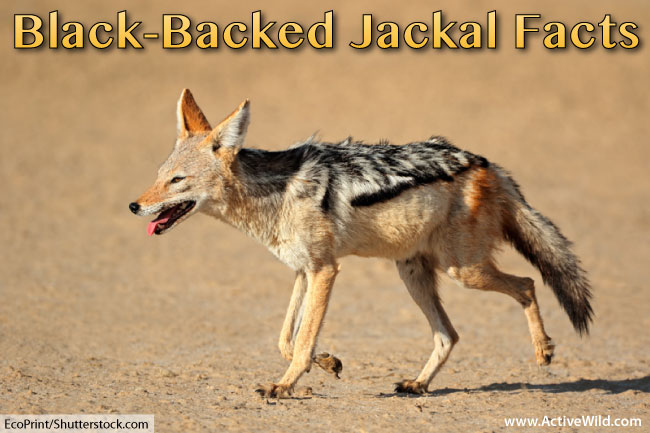
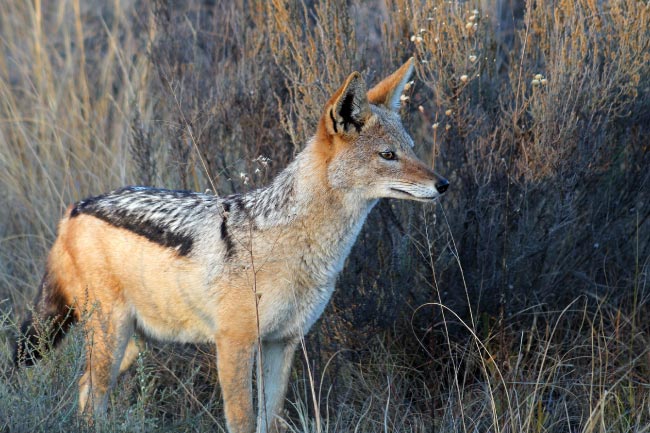
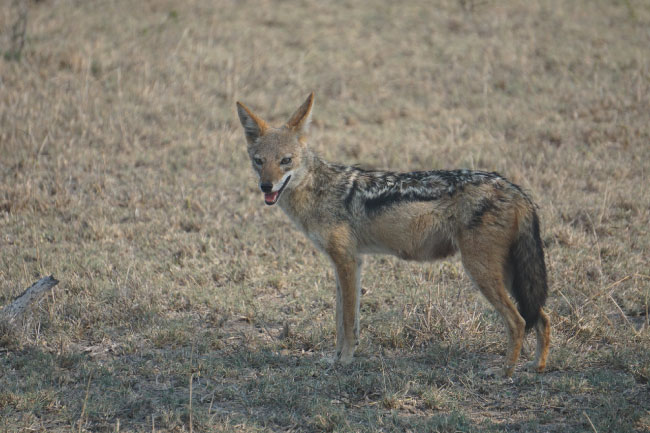
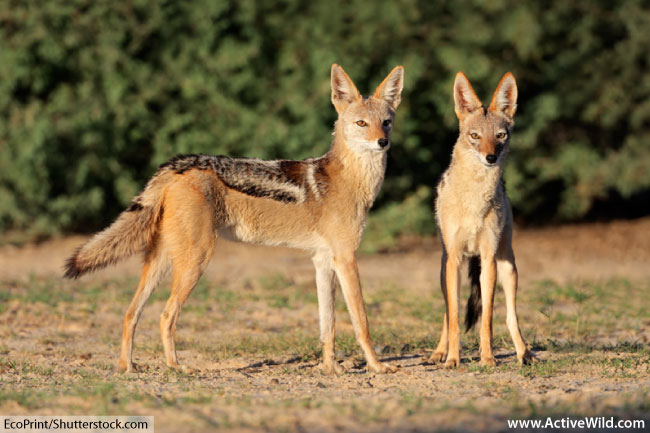
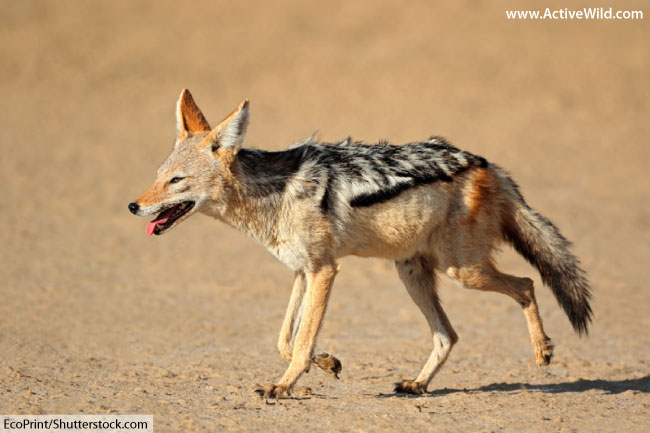

My springboks at my garden were beaten in the neck left dead and the duck is also beaten is in pain chicken were eaten rough I thought was a jackal what can do this to home animals?
That’s a difficult question to answer. It’s possible, but, depending on your location and property, it could be any number of species.
We suggest you speak to a local wildlife organisation.
Regards,
The Active Wild Team